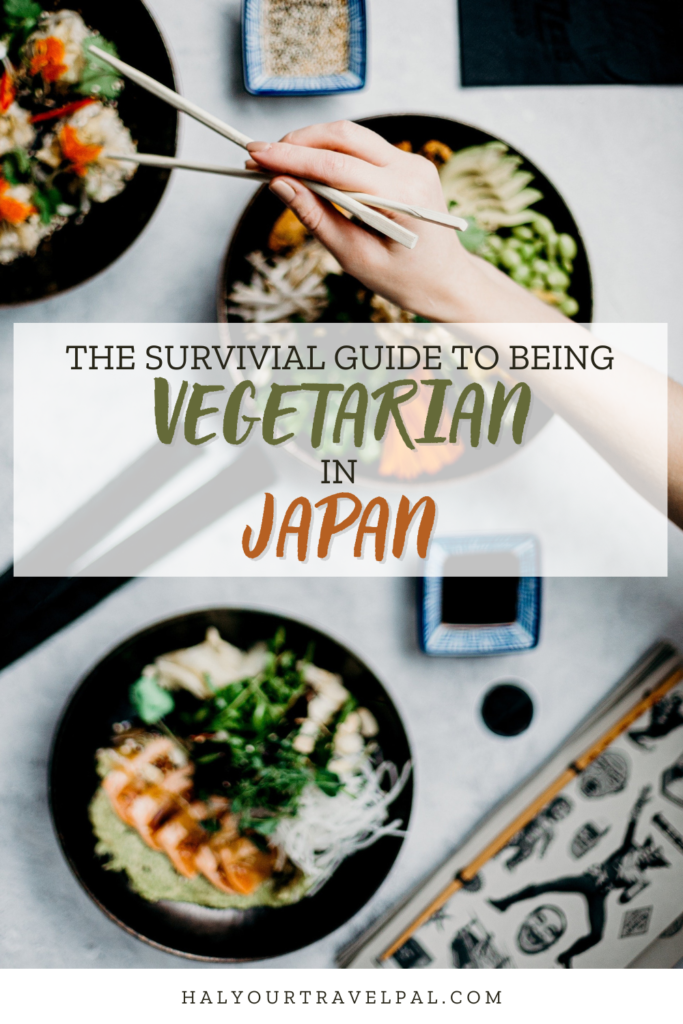
This post may contain affiliate links and I may earn a small commission when you click on the links at no additional cost to you. You can read my full privacy policy here.
Navigating a foreign country as a vegetarian can be intimidating. Japan is no exception, with its cuisine being heavy in meats and fish, and vegetarianism and veganism being less popular than in the West. However, with some preparation and the proper resources, you will find delicious plant-based options without too much of a struggle. As a vegetarian, Japan is one of my favorite destinations for food travel! You just need to know how to find options and come prepared. My top advice is to map out lots of options in advance along your travel route. That way, you can easily choose a delicious and convenient option whenever and wherever you get hungry. Keep reading for my top tips on how to not only survive but thrive as a vegetarian (or vegan) in Japan.
I’m vegetarian, so this guide is mostly focused on vegetarianism in Japan. However, a lot of these tips work for vegans too! You will also find that a lot of vegetarian options ARE vegan.
Don’t know how or where to start planning your Japan itinerary? Check out my ultimate Japan guide and 2-week itinerary!
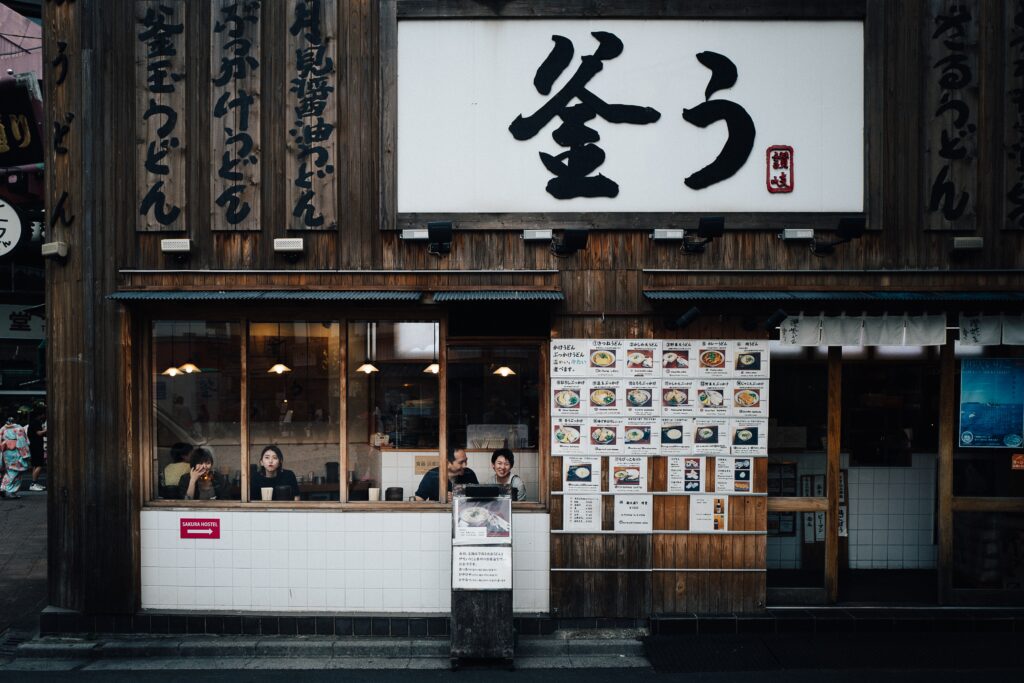
Tips for being vegetarian in Japan
- Print a dietary restriction card from Just Hungry for an easy way to communicate your exact dietary restrictions with restaurant workers. There are lots of options for a range of different dietary restrictions.
- Understand what “dashi” is and decide whether or not you are okay with eating it. Dashi is a soup stock made with fish-based ingredients, and it is in just about every savory dish in Japanese cuisine. If you decide to consume dashi, it will make your culinary experience in Japan a lot less limited. If you decide to not consume it, be thorough when checking dishes for its use (many Japanese people will assume vegetarians CAN eat dashi). The aforementioned dietary restriction cards can help clarify one way or another, as there is a card for both including and excluding dashi in your diet.
- Base your trip in major cities, such as Tokyo, Kyoto, and Osaka. While you don’t need to (and shouldn’t!) exclusively stay in these areas, they are significantly easier to navigate with dietary restrictions. There are constantly expanding options with a wide array of veggie-fied Japanese cuisine. I encourage you to branch out from these cities as you will be able to find options that work for you in smaller towns, but for ease and convenience, spending at least a portion of your trip in these cities will relieve some of the burden.
- Don’t underestimate 7/11! This will be the best convenience store food you’ve ever had. There are always plenty of veggie options, from snacks to meals, and it’s all very affordable. The few times I found myself in a pinch and couldn’t find a suitable veggie-friendly restaurant around, the nearest 7/11 was my best friend.
- Enjoy Zen Buddhist temple cuisine, known as shojin ryori. These multi-dish meals are healthy, delicious, and vegan. You can find shojin ryori in lots of temples, but you can also find it offered in traditional restaurants. While they can be expensive, I recommend you try it at least once!
- Know what Japanese foods are likely to be vegetarian or come in a vegetarian option. According to this article by byFood, these include:
- Vegetable tempura – deep fried vegetables
- Shojin ryori – Zen Buddhist temple cuisine, mentioned above
- Nasu dengaku – grilled eggplant
- Zaru soba – cold buckwheat noodles
- Vegetarian sushi – look for kappa maki (cucumber rolls), takuan maki (pickled daikon rolls) and inarizushi (rice stuffed inside deep-fried tofu pockets)
- Vegetarian onigiri – rice balls
- Vegetarian ramen
- Vegetarian udon – chewy, thick wheat noodles
- Vegetable gyoza – dumplings
- Vegetarian okonomiyaki – savory pancake typically made with flour, eggs, and cabbage
- Vegetarian donburi – rice bowl
- Know what apps to download to optimize your search for the most and best options! Keep reading for my app suggestions.
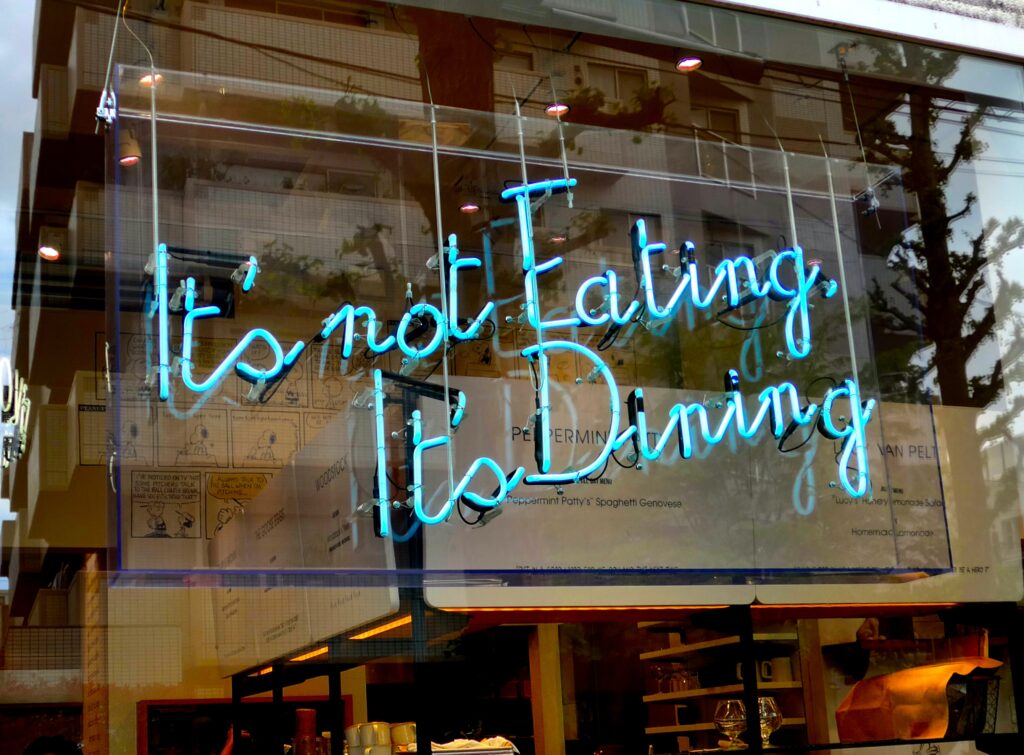
Apps to download for vegetarians in Japan
Google Maps (free)
Google Maps is an absolutely essential app to use in Japan. Not only is the navigation extremely reliable for getting around using public transportation, but Google Maps will be your best friend for searching and mapping out veggie options. Once you know your travel route in Japan, do a preliminary Google Search for “vegetarian (or vegan) restaurants in ____.” Create a saved list on Google Maps where you can save these suggestions for easy, location-based access during your travels.
Another great way to use Google Maps to your advantage is to simply search “vegetarian” or “vegan” in the search bar on the app, with the location set to the area you want to search. This will pull up any restaurants that mention these keywords in the reviews, which allows you to discover some hidden gems that the rest of the internet might not know about yet. For an even more thorough search, you can copy and paste the Kanji for “vegetarian” in the search bar: “ベジタリアン”.
HappyCow ($3.99)
HappyCow is my all-time favorite app for finding veggie-friendly restaurants worldwide throughout my travels. However, it was especially helpful in Japan, where finding vegetarian options is a little more difficult than in other parts of the world. It uses your current location to pull up a map of vegetarian and vegan options nearby. It’s color-coded to distinguish between restaurants that are vegan, vegetarian, and offer vegan options. You’ll find reviews and photos from other plant-based visitors, allowing you to choose the best of the best options. It’s currently $3.99 on the App Store, but it is worth much more for how much trouble it will save you!
Google Translate (free)
Did you know that less than 30% of Japanese people speak any English at all? You’re going to need a good translation app, and I recommend Google Translate because it allows you to translate both sides of a spoken conversation in real time. You can also take a picture of anything (like a menu) and it will translate the entire page. If you find yourself in a restaurant with a menu fully in Japanese and staff with no English knowledge (which WILL happen!), Google Translate will get you by.
Airalo (free, cost varies for eSIMs)
To use all these apps on the go and find vegetarian options no matter when or where, you’re going to need a data plan! My favorite option for accessing the Internet across the world is the Airalo eSIM. An eSIM doesn’t need to be physically put in and taken out; it’s simply installed onto your phone and connects to Internet anywhere in the world as soon as you land. Instead of wasting time looking for a local plastic SIM, you can activate the eSIM immediately after installation or upon arrival in Japan. This is the easiest and most convenient option, and it’s reliable. I’ve used Airalo all over the world and I’m always a happy customer. Plus, if you are continuing your travels after Japan, you can get a regional Asia eSIM that works in 14 countries.
Keep in mind that eSIMs only provide data service for connecting to the Internet, not calling and texting plans. If you need to make calls or send texts abroad, then you can pick up a physical SIM card at the airport upon arrival by pre-ordering here.
My favorite restaurants for vegetarians in Japan
Tokyo vegetarian restaurants
Himawari Sushi Shintoshin – conveyor belt sushi, Shinjuku
A visit to Japan isn’t complete without a meal at a conveyor belt sushi restaurant. You watch all the sushi and side dishes circle in front of you, grabbing whatever looks appealing. You can also order directly with the chefs if you want something that is not currently circling on the belt. Although not all sushi restaurants will offer vegetarian or vegan options, being vegetarian in Japan doesn’t have to stop you from enjoying it! Himawari Sushi Shintoshin offers multiple marked vegetarian options on the menu, and will make special requests off-menu. We had to order these instead of grabbing them off of the belt, but it didn’t take away from the overall experience. Make sure to grab some freshly steamed edamame off the belt – you’ll want more than one bowl!

Zen – okonomiyaki, Shinjuku
Before I went to Japan, I had never heard of okonomiyaki. This delicious cabbage pancake became my favorite Japanese food by the time my trip was over. Zen offers both vegetarian and non-vegetarian okonomiyaki options, in both the traditional and Hiroshima styles (“hiroshimayaki” is made with thinner batter and yakisoba noodles). For a hearty, filling meal for meat eaters and non-meat eaters alike, head to Zen. It’s right next to the Golden Gai, so follow up your meal with a delicious cocktail in one of the iconic tiny bars.
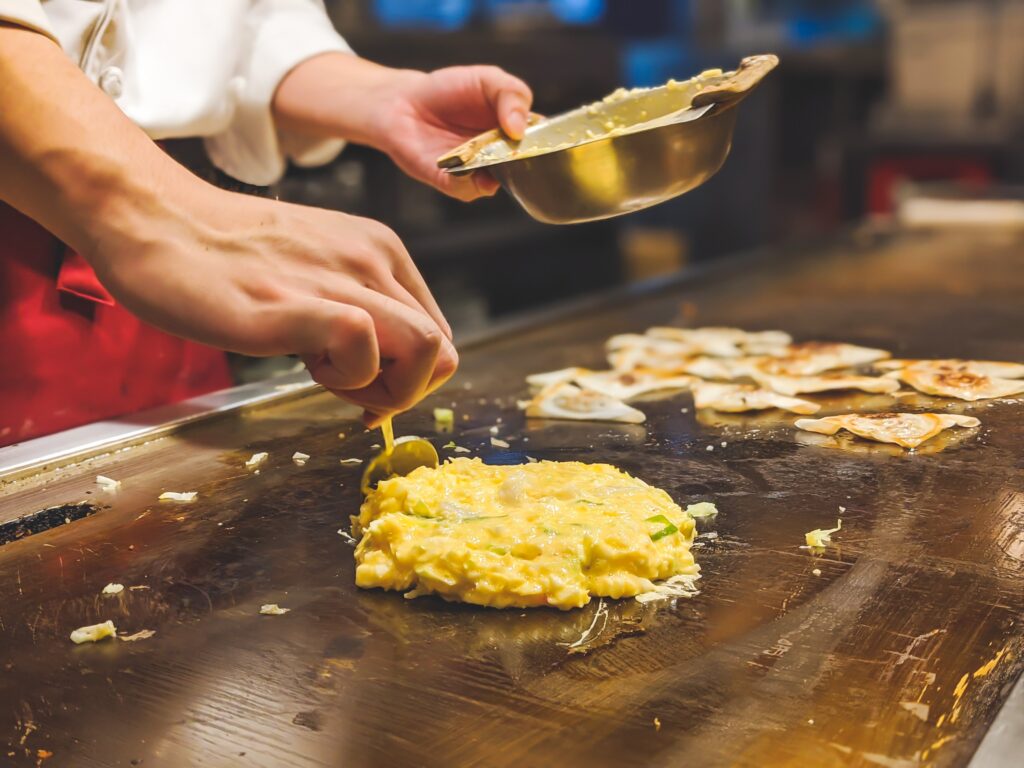
T’s TanTan – vegan ramen, multiple locations
For creamy, nutty, rich, vegan ramen, head to one of T’s TanTan’s locations and order the Golden Sesame Ramen. It’s absolutely delicious and so satisfying. I also recommend ordering a side of the vegan gyoza. They have other delicious flavors of ramen if the Golden Sesame doesn’t sound like it will hit the spot. These locations usually have a wait, so I recommend either showing up at non-peak eating times or preparing to wait.

Kyushu Jangara – ramen, multiple locations
Kyushu Jangara offers both a vegan and a vegetarian soy sauce ramen. This style of ramen is very different than the sesame ramen offered at T’s TanTan, so I recommend you try both. It comes with vegan char-siu, a delicious vegan substitute for the typical roast meat. This is also a very popular restaurant, so plan to wait a while if you don’t time it well. Unlike T’s TanTan, this is not a fully vegan restaurant, so there are satisfying options for meat eaters as well.

Let’s plan your plant-based Japan adventure
I’ve visited Japan multiple times as a vegetarian, so I know firsthand the challenges, best spots, and insider tips. As a travel advisor specializing in Asia travel, let me help you design a custom Japan itinerary so you can focus on enjoying your trip without the stress of finding a meal.
Let’s start planning your perfect vegetarian-friendly Japan trip today!
Kyoto vegetarian restaurants
Gyoza ChaoChao – gyoza, multiple locations
For a wide selection of vegan and vegetarian gyoza, head to Gyozo ChaoChao. They have an entirely separate menu with both vegan and vegetarian options clearly marked. The staff spoke good English and were extremely friendly, making our overall experience very enjoyable for both vegetarians and meat eaters alike. Don’t miss out on ordering the chocolate gyoza for dessert!

Mimikou – udon, Higashiyama Ward
Mimikou is known for its curry udon and has a separate menu with clearly marked options for vegans and vegetarians. The veggie menu offers a few options for curry rice and curry udon. I recommend you try the curry udon as it’s famous, and I couldn’t find another vegetarian curry udon during the rest of my travels! Its rich and unique flavor is something you don’t want to miss out on.

Pelgag – Western with many vegan options, Nakagyo Ward
I don’t usually deviate from eating the local cuisine when I’m traveling, but I’m so glad that I did for Pelgag. Their take on Western food, from Egyptian spicy noodles to a Moroccan vegetable plate, will not disappoint. Many options on the menu are vegan, with even more being vegetarian. The restaurant was adorable and the presentation was beautiful. Sometimes you will need a break from constantly eating Japanese food, and you won’t be disappointed here.
Osaka vegetarian restaurants
OKO – vegan & vegetarian okonomiyaki, Chuo
For fully customizable vegan and vegetarian okonomiyaki, head to OKO! This was one of my favorite culinary experiences in all of Japan, and it really is an experience. You get to build your own okonomiyaki with your choice of toppings, and all alcohol is self-serve (and so cheap!) at a cute bar in the corner. The restaurant is decorated brightly and uniquely, making it such a lively and cute place. This is a must for any vegetarian or vegan in Osaka!
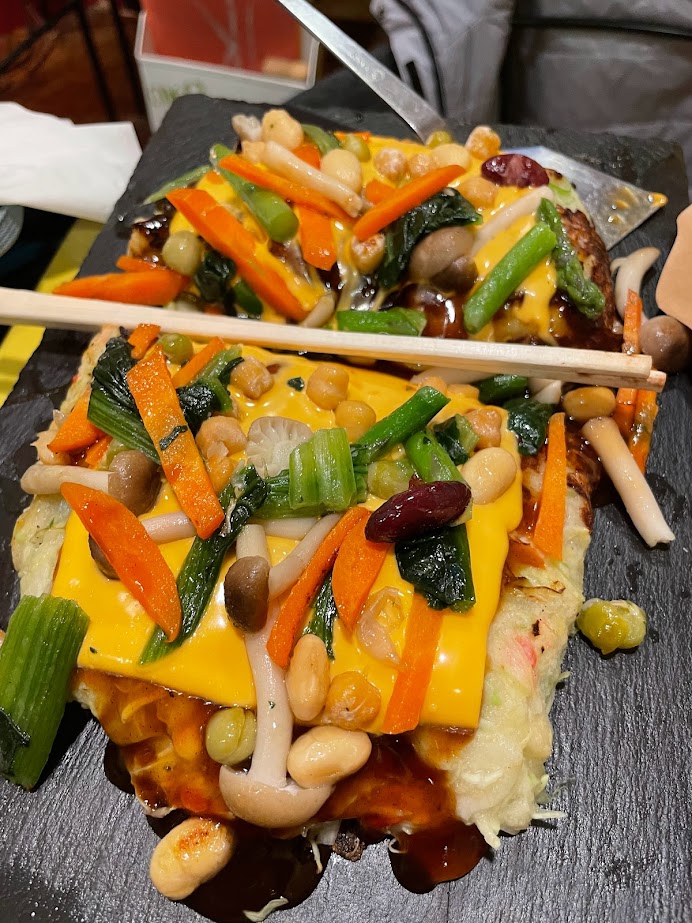
A Happy Pancake – Japanese-style souffle pancakes, multiple locations
At least once while you’re in Japan, you must try the Japanese-style soufflé pancakes. These are much lighter and fluffier than typical pancakes because they’re made by whipping lots of egg whites (so unfortunately, there is no vegan option). A Happy Pancake is a great place to try them because of their wide variety of flavors on the menu, from chocolate to fruits to a mixture of both.
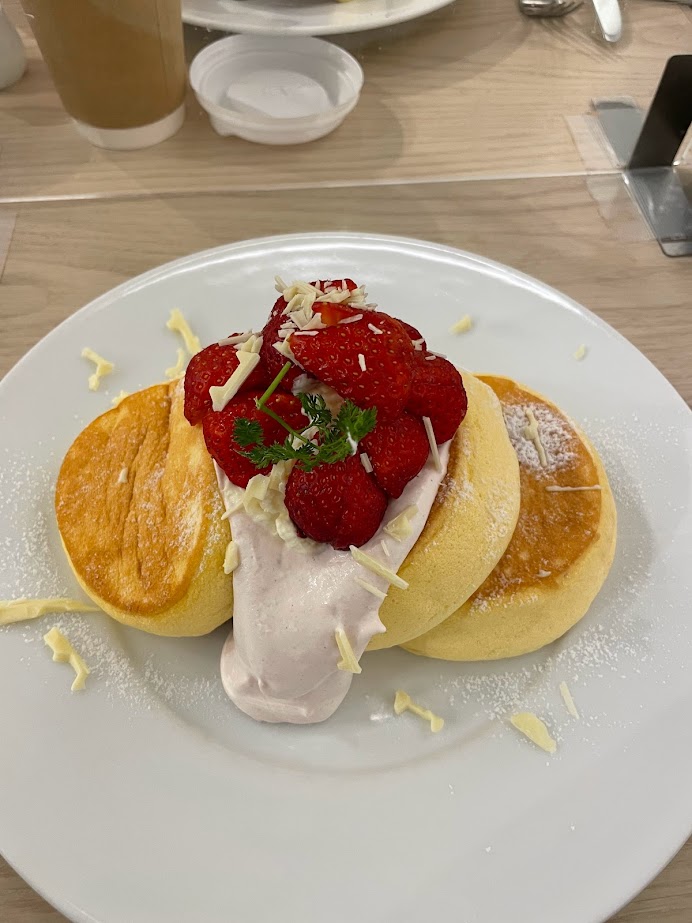
Himeji vegetarian restaurants
Sakurasaku – set meals, Himeji
If you take a day trip to Himeji Castle (something I really recommend, read more about it in my Japan ultimate guide and itinerary), you absolutely must stop at Sakurasaku. This small, family-run cafe has a delicious traditional set meal for a good price. There are vegan, vegetarian, and gluten-free sets available, along with a couple of meat options for meat eaters. Our set came with delicious sides in a bento box-style meal, and we even got a piece of strawberry chiffon cake to top it all off. The owner is a lovely woman who asked us all about our family. Don’t miss out on this traditional meal experience.

Hiroshima vegetarian restaurants
Nagataya – Hiroshima-style okonomiyaki, Naka Ward
An okonomiyaki recommendation again? Seriously, you will fall in love with this dish. By the time you reach Hiroshima, you will need to try Hiroshima-style okonomiyaki, also known as “Hiroshimayaki”. Hiroshimayaki is made with a thinner batter than the traditional version, and they include yakisoba noodles inside. I actually came to prefer it over the traditional version, although I love both! Nagataya is a very famous place to try it, with multiple vegan and vegetarian options to choose from on a separate menu. There is always a wait, but it will be very worth it.

Wildman Bagel – bagels, Naka Ward
I never thought I would be recommending a bagel place in Japan, but I found some of the best bagels I’ve ever had. Right next to the Peace Park and Museum, this little bagel joint serves unique bagel flavors that will start your day on the right foot. We got our bagels to go and I almost made everyone go back to get more once we tried them! Get a few flavors to try, and the pastries are great as well.

What sounds good to you? Save these suggestions, along with any other options you find using these resources, to your Google Maps now so you can easily pull them up during your trip! Now you have all the information you need to be properly prepared to fully enjoy Japan as a vegetarian, without too much extra effort. You’re going to find that being vegetarian in Japan is a delicious, satisfying, and healthy experience.
Book Your Japan Excursions
Eating your way around the country is just one of the many amazing things to do in Japan. The best activity and excursion booking platforms for Japan are Klook and GetYourGuide. Both websites have thousands of trustworthy travel experiences with verified user reviews. I use Klook and GetYourGuide to book almost all my excursions in Asia.
Book Your Japan Accommodation
Need amazing hotels or hostels for your Japan trip? The best booking platform for finding and reserving great hotels in Japan is Agoda. It’s owned by the same company as Booking.com but is based in Asia, making it great for finding any hotels you need. If you’re a backpacker staying in hostels, then Hostelworld is consistently the best hostel booking platform worldwide, and Japan is no exception. Book your Japan accommodation on Agoda today:
Keep reading:
- Tokyo Itinerary: 3-5 days for first-time visitors
- 2 week Japan itinerary and travel guide
- Solo travel in Japan: Safety, tips, & what to expect
- Vegetarian in Korea: The ultimate survival guide
- The survival guide to being vegetarian (& vegan) in Taiwan
- The best vegetarian and vegan restaurants in Seoul (2024)
- 5 Asia honeymoon destinations that are anything but ordinary
- QUIZ: Which Asian country should I visit?



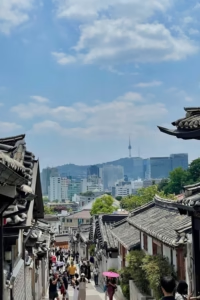
Leave a Reply